View in other NatureServe Network Field Guides
NatureServe
Montana
Utah
Wyoming
Idaho
Wisconsin
British Columbia
South Carolina
Yukon
California
New York
Cusick's Horsemint - Agastache cusickii
State Rank Reason (see State Rank above)
This species is known in Montana from only a few locations in the Tendoy and Beaverhead Mountains. The steeply sloping habitat and relative remoteness of most populations minimizes its vulnerability to grazing and timber harvest -- the principle current land uses. However, these slopes can be vulnerable to destabilization if impacted by activities such as mining or road maintenance; the largest occurrence is in an area that is quarried for rock/gravel.
General Description
Cusick's Horse-mint is an herbaceous, long-lived perennial with numerous stems, woody at the base arising from a branched rootcrown surmounting a taproot. Plants are 1-2 dm high, but the stems often lie prostrate beneath the surface spreading from the rootcrown. Opposite leaves have blades that are 1-2 cm long and triangular with a rounded base and a petiole that is up to 1 cm long. Foliage is covered with fine, short hairs. White flowers are borne amongst purple-tipped bracts in a head-like inflorescence that is 1.5-4 cm long. The tubular corolla is 8-12 mm long, and the purple-tinged calyx is tubular with 5 pointed lobes. The 5 stamens are exserted from the mouth of the flower tube.
Phenology
Flowering occurs in late June and July.
Diagnostic Characteristics
The related nettle-leaf horsemint (Agastache urticifolia) is taller (at least 4 dm) and has larger leaves.
Species Range
Montana Range
Range Descriptions
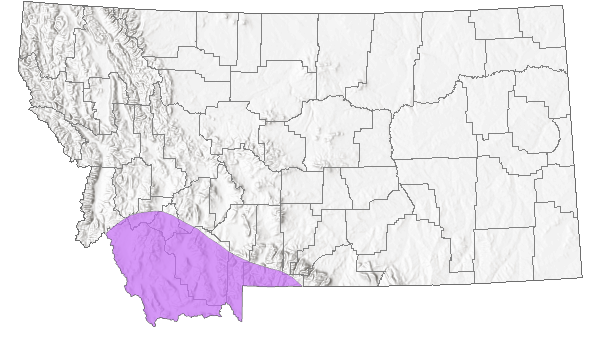
 Native
Native
Range Comments
Harney & Malheur Cos., Oregon and at scattered locations in the mountains of central Idaho, northern and central Nevada, southwesternmost Montana, and possibly northeastern California; in Steens, Santa Rosa, White Pine, and Toiyabe Mountains of Nevada.
Observations in Montana Natural Heritage Program Database
Number of Observations: 9
(Click on the following maps and charts to see full sized version)
Map Help and Descriptions
Relative Density
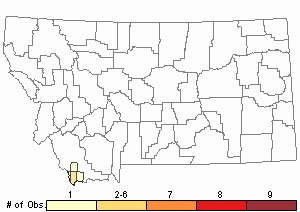
Recency
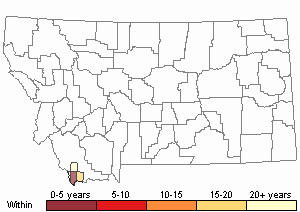

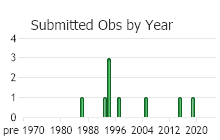
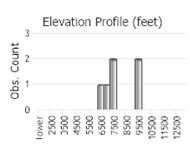 (Observations spanning multiple months or years are excluded from time charts)
(Observations spanning multiple months or years are excluded from time charts)
Habitat
In the Tendoy Mountains, Cusick's horesmint grows on open slopes with little vegetation cover. The populations are primarily on steep, loose talus below limestone outcrops, often in chutes, with a few plants usually occupying talus deposits at the base of the slope. On the Beaverhead National Forest, this species is confined to the south-facing slopes of narrow canyons, across a wide range of elevations (Vanderhorst 1995). One lower-elevation occurrence occupies the slope above a broad valley.
Woody dominants include limber pine, Douglas fir, mountain mahogany (Cercocarpus ledifolius), big sagebrush (Artemisia tridentata), and a gooseberry (Ribes setosum). Major grasses include bluebunch wheatgrass and spike-fescue (Leucopoa kingii). Frequently associated forbs include the talus-adapted perennials Arenaria nuttallii, Oenothera caespitosa, Phacelia hastata, and Penstemon montanus, and annuals such as Collinsia parviflora and Polygonum douglasii.
Ecological Systems Associated with this Species
Ecology
Agastache cusickii seems to be confined to areas of smaller-size talus. The substrate is constantly settling and shifting and is easily disturbed. Soil development is minimal on the limestone talus where the species grows in the Tendoys, however at one site where the banks have been cut by quarrying, some horizonation was noted (Vanderhorst 1995). The upper zone of the talus is extremely well-drained, however clays provide a higher water-holding capacity in the lower zone. This steep habitat is not generally susceptible to fire; the species may sprout from the caudex following disturbance (USDA, Fire Effects Information System, http://www.fs.fed.us/database/feis/).
POLLINATORS The following animal species have been reported as pollinators of this plant species or its genus where their geographic ranges overlap:
Bombus appositus,
Bombus centralis,
Bombus flavifrons,
Bombus nevadensis,
Bombus ternarius,
Bombus griseocollis,
Bombus impatiens,
Bombus insularis, and
Bombus suckleyi (Thorp et al. 1983, Johnson 1986, Mayer et al. 2000, Colla and Dumesh 2010, Williams et al. 2014).
Management
This species' habitat is by nature easily disturbed, however all occurrences on the Beaverhead National Forest are in remote, relatively undisturbed sites (Vanderhorst 1995). The steepness of this habitat tends to make it inaccessible to cattle, and the timber on these slopes is not of commercial quality (Vanderhorst 1995).
One large population on a lower-elevation valley slope lies along a major gravel road, where past quarrying of limestone talus has reduced the habitat extent, and road maintenance could impact bank stability. Roads are also found in some canyon bottoms where the species occurs, but these are infrequently traveled. Future road improvement or maintenance and other canyon-bottom activities could be managed to avoid impacting the populations and habitat.
Stewardship Responsibility
Threats or Limiting Factors
STATE THREAT SCORE REASON
Reported threats to Montana’s populations of Cusick's Horsemint are related to some roadside populations where gravel mining and herbicide application are persistent (MTNHP Threat Assessment 2021). The largest population in addition to others are found along a remote county road near a rock quarry where gravels are regularly collected for road maintenance. Herbicide application is also known to occasionally destroy plants along this road.
References
- Literature Cited AboveLegend:
 View Online Publication
View Online Publication Colla, S.R. and S. Dumesh. 2010. The bumble bees of southern Ontario: notes on natural history and distribution. Journal of the Entomological Society of Ontario 141:39-68.
Colla, S.R. and S. Dumesh. 2010. The bumble bees of southern Ontario: notes on natural history and distribution. Journal of the Entomological Society of Ontario 141:39-68. Johnson, R.A. 1986. Intraspecific resource partitioning in the bumble bees Bombus ternarius and B. pennsylvanicus. Ecology 67:133-138.
Johnson, R.A. 1986. Intraspecific resource partitioning in the bumble bees Bombus ternarius and B. pennsylvanicus. Ecology 67:133-138. Mayer, D.F., E.R. Miliczky, B.F. Finnigan, and C.A. Johnson. 2000. The bee fauna (Hymenoptera: Apoidea) of southeastern Washington. Journal of the Entomological Society of British Columbia 97: 25-31.
Mayer, D.F., E.R. Miliczky, B.F. Finnigan, and C.A. Johnson. 2000. The bee fauna (Hymenoptera: Apoidea) of southeastern Washington. Journal of the Entomological Society of British Columbia 97: 25-31. MTNHP Threat Assessment. 2021. State Threat Score Assignment and Assessment of Reported Threats from 2006 to 2021 for State-listed Vascular Plants. Botany Program, Montana Natural Heritage Program, Helena, Montana.
MTNHP Threat Assessment. 2021. State Threat Score Assignment and Assessment of Reported Threats from 2006 to 2021 for State-listed Vascular Plants. Botany Program, Montana Natural Heritage Program, Helena, Montana. Thorp, R.W., D.S. Horning, and L.L. Dunning. 1983. Bumble bees and cuckoo bumble bees of California (Hymenoptera: Apidae). Bulletin of the California Insect Survey 23:1-79.
Thorp, R.W., D.S. Horning, and L.L. Dunning. 1983. Bumble bees and cuckoo bumble bees of California (Hymenoptera: Apidae). Bulletin of the California Insect Survey 23:1-79. Williams, P., R. Thorp, L. Richardson, and S. Colla. 2014. Bumble Bees of North America. Princeton, NJ: Princeton University Press. 208 p.
Williams, P., R. Thorp, L. Richardson, and S. Colla. 2014. Bumble Bees of North America. Princeton, NJ: Princeton University Press. 208 p.
- Additional ReferencesLegend:
 View Online Publication
View Online Publication
Do you know of a citation we're missing? Lesica, P., M.T. Lavin, and P.F. Stickney. 2012. Manual of Montana Vascular Plants. Fort Worth, TX: BRIT Press. viii + 771 p.
Lesica, P., M.T. Lavin, and P.F. Stickney. 2012. Manual of Montana Vascular Plants. Fort Worth, TX: BRIT Press. viii + 771 p. Lesica, P., M.T. Lavin, and P.F. Stickney. 2022. Manual of Montana Vascular Plants, Second Edition. Fort Worth, TX: BRIT Press. viii + 779 p.
Lesica, P., M.T. Lavin, and P.F. Stickney. 2022. Manual of Montana Vascular Plants, Second Edition. Fort Worth, TX: BRIT Press. viii + 779 p. U.S. Department of Agriculture, Forest Service, Rocky Mountain Research Station, Fire Sciences Laboratory. 2000. Fire Effects Information System
U.S. Department of Agriculture, Forest Service, Rocky Mountain Research Station, Fire Sciences Laboratory. 2000. Fire Effects Information System Vanderhorst, J. P. 1993. Monitoring of Agastache cusickii in the Tendoy Mountains of Southwestern Montana: Establishment Report. Unpublished Report to the Bureau of Land Management, Butte District, Dillon Resource Area. Montana Natural Heritage Program, H
Vanderhorst, J. P. 1993. Monitoring of Agastache cusickii in the Tendoy Mountains of Southwestern Montana: Establishment Report. Unpublished Report to the Bureau of Land Management, Butte District, Dillon Resource Area. Montana Natural Heritage Program, H Vanderhorst, J.P. and P. Lesica. 1995a. Sensitive plant survey of the Tendoy Mountains in the Beaverhead National Forest, Beaverhead County, Montana. Unpublished report to the Bureau of Land Management, Butte District. Montana Natural Heritage Program, Helena, MT. 59 pp. plus appendices.
Vanderhorst, J.P. and P. Lesica. 1995a. Sensitive plant survey of the Tendoy Mountains in the Beaverhead National Forest, Beaverhead County, Montana. Unpublished report to the Bureau of Land Management, Butte District. Montana Natural Heritage Program, Helena, MT. 59 pp. plus appendices.
- Web Search Engines for Articles on "Cusick's Horsemint"





